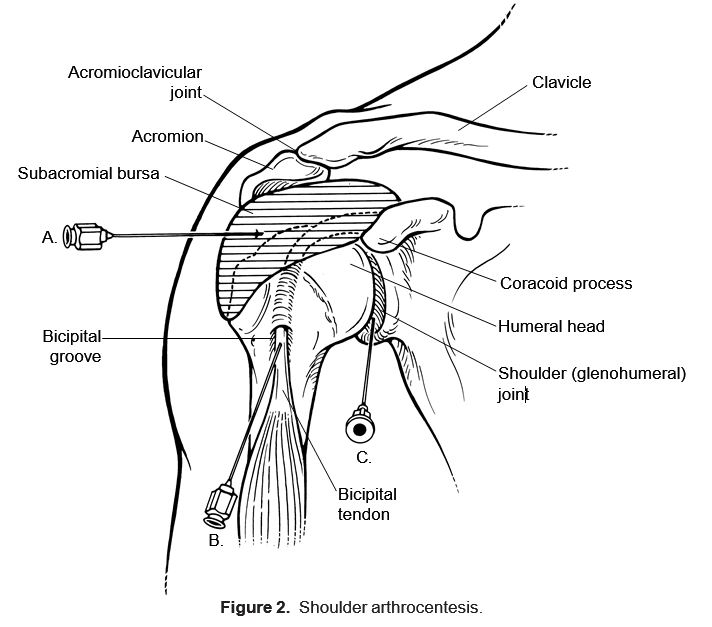Arthrocentesis & Injections: Shoulder (Glenohumeral)
Last updated: October 15, 2014
Patient Position: The patient should be seated upright with the shoulder joint fully exposed.
Limb Position: Place the patient’s arms at the side, with hands on lap and palms facing upward so that the glenohumeral joint is partially externally rotated.
Bony Landmarks: Palpate the acromion (laterally), humeral head and coracoid process (anteriorly), bicipital tendon and groove (anterolaterally), and the acromioclavicular joint (superiorly). The humeral head is best palpated by placing the thumb over the joint anteriorly and having the patient internally and externally rotate the humerus.
Site/Angle of Entry: To inject or aspirate the glenohumeral joint (Figure 2C), the entry site is anterior to where the humeral head can be felt to rotate inward and disappear under the thumb during rotation. This site is just inferior and lateral to the coracoid process (Fig. 2C). The axis of entry is parallel to the ground, directly into the shoulder but angled (10–15 degrees) toward the midscapula. The needle should be fully advanced (>3 cm) to enter the joint. Aspirate before injecting. Some rheumatologists prefer the posterior approach. Using the same position and materials, the needle is placed ~2-3cm below the posterior lateral acromial corner or mid-way between and the posterior lateral acromial corner and the posterior axillary crease. The needle is advanced in the direction of the coracoid process.
Amount of Injection: Use 20 to 40 mg Depo-Medrol (or equivalent), with or without 0.5 mL of 1% lidocaine, in a total volume of 1 to 5 mL.
Other Injectable Sites: The subacromial (subdeltoid) bursa may be injected using the same patient/limb position (Fig. 2). Use 20 to 40 mg Depo-Medrol (or equivalent) with 0.5 mL of 1% lidocaine. After locating the point of maximal tenderness, enter laterally 1 cm beneath the acromion (Fig. 2A), with the needle axis parallel to the ground. The bicipital tendon (Fig. 2 B) may be injected tangentially after palpating the tendon, bicipital groove, and point of maximal tenderness. Do not inject into the tendon but instead inject close to the tendon sheath by advancing the needle until the tendon is felt, then withdrawing 1 to 2 mm.
Comment: Concomitant use of lidocaine allows the operator to gauge the adequacy of injection because many patients can “suddenly” move the shoulder more freely and without pain at the completion of the procedure.



